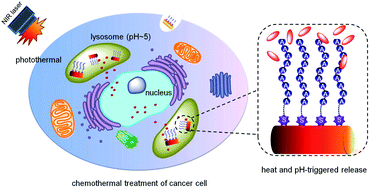The adenine DNA self-assembly of pH- and near-infrared-responsive gold nanorod vehicles for the chemothermal treatment of cancer cells†
Abstract
Despite the remarkable progress in the construction of nanostructures for drug delivery in cancer therapy, multifunctional nanoplatforms with synergistic advantages over any single-model nanostructures are still encouraging. Herein, a dual pH- and near-infrared (NIR)-responsive nanotherapeutic system for the chemothermal treatment of cancer cells was achieved by using adenine DNA coated gold nanorod vehicles (poly(A)/AuNR). The poly(A)/AuNRs were prepared by self-assembling thiolated poly(A) on the surface of the AuNRs via Au–S bonding. In this system, the poly(A) provided the ability to load coralyne, a model chemotherapeutic drug, through adenine–coralyne–adenine specific binding. Under low-pH or high-temperature conditions, adenine–coralyne–adenine would be unstable, leading to the stimuli-responsive release of coralyne for cancer chemotherapy. The AuNRs showed a high efficiency for the conversion of NIR light into heat, providing the fundamental basis of hyperthermal cancer therapy, and also promoting the triggered release of coralyne from poly(A) upon NIR irradiation. The characteristics of the poly(A)/AuNRs have been investigated by using TEM and UV-vis spectroscopy. It was shown that about 160 copies of poly(A) could be assembled on one AuNR prepared with the dimensions of about 30 nm in length and 10 nm in width, and each poly(A)/AuNR could load about 2500 coralyne molecules. The in vitro studies using human hepatoma SMMC-7721 cells demonstrated that the coralyne loaded poly(A)/AuNRs could be endocytosed and demonstrated an efficient operation in a cellular acidic environment and NIR irradiation, leading to significant cytotoxicity through the excellent chemothermal synergistic effects. We believe that this developed multimode nanostructure will provide potential applications for cancer therapy.


 Please wait while we load your content...
Please wait while we load your content...